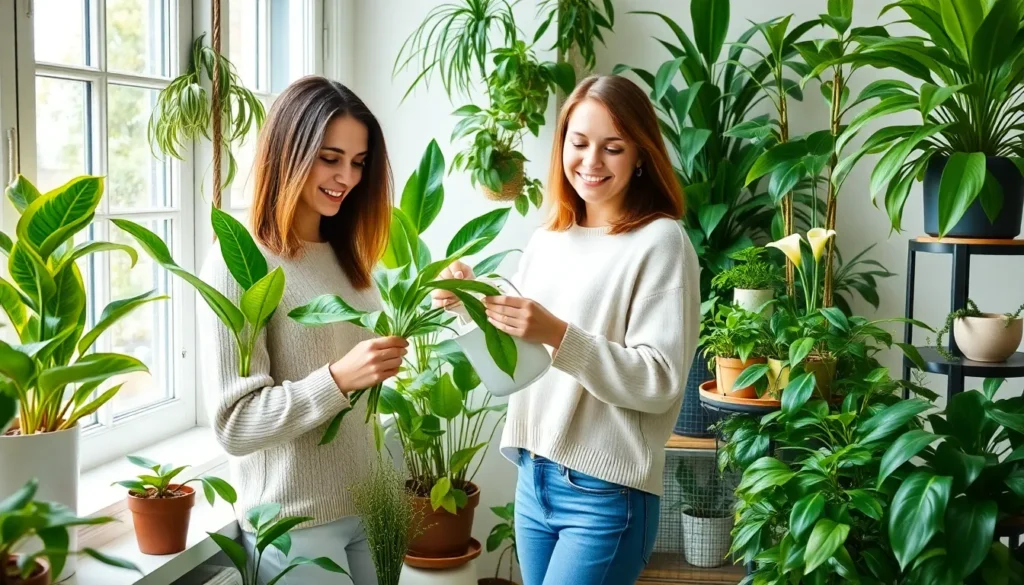Transform your living space into a thriving green oasis with indoor plants that bring life and vitality to every corner of your home. We’ve discovered that home gardening doesn’t require a sprawling backyard – your windowsills, shelves and even dimly lit corners can become flourishing garden spaces with the right plant choices and techniques.
Indoor gardening offers incredible benefits beyond just aesthetic appeal. We’re talking about cleaner air, reduced stress levels and the satisfaction of nurturing living things right from your couch. Whether you’re a complete beginner or looking to expand your current collection, there’s an indoor plant solution that’ll work perfectly for your lifestyle and space.
Ready to jump into the industry of indoor gardening? We’ll share proven strategies for selecting low-maintenance plants, creating stunning displays and troubleshooting common issues that trip up new plant parents. Your dream indoor garden is closer than you think – and it starts with choosing the right plants for your unique space.
Choose Low-Maintenance Indoor Plants for Beginners
Starting your indoor gardening journey becomes much easier when you select plants that forgive occasional neglect and thrive in various conditions.
Snake Plants and ZZ Plants
Snake plants (Sansevieria trifasciata) top our list for their incredible drought tolerance and ability to survive in low light conditions. These architectural beauties can go weeks without water and actually prefer to dry out completely between waterings. We love how their upright, sword-like leaves add vertical interest to any room while requiring minimal attention.
ZZ plants (Zamioculcas zamiifolia) earn their reputation as nearly indestructible houseplants through their waxy, glossy leaves that store water efficiently. They tolerate neglect better than most plants and can survive in fluorescent office lighting or dim corners of your home. Watering them once every 2-3 weeks during growing season keeps them perfectly happy.
Both varieties excel in various humidity levels and forgive beginners who tend to overwater or underwater their plants. Their slow growth means less frequent repotting, making them ideal starter plants for busy lifestyles.
Pothos and Philodendrons
Pothos varieties offer trailing vines that create stunning displays on shelves, hanging baskets, or climbing up moss poles. These adaptable plants root easily in water, making propagation incredibly simple for expanding your collection or sharing with friends. We recommend starting with golden pothos or marble queen varieties for their striking variegated foliage.
Philodendrons share similar care requirements with pothos but offer different leaf shapes and growth patterns. Heartleaf philodendrons cascade beautifully from elevated positions, while split-leaf varieties like monstera deliciosa create dramatic focal points. Both plant families indicate their watering needs clearly through slightly drooping leaves.
These vining plants thrive in bright, indirect light but tolerate lower light conditions without major complaints. Their quick growth provides instant gratification for new plant parents eager to see results from their care efforts.
Spider Plants and Peace Lilies
Spider plants (Chlorophytum comosum) produce charming plantlets or “babies” on long, arching runners that make propagation effortless and fun. These striped green and white plants adapt to various lighting conditions and bounce back quickly from occasional watering mistakes. We appreciate how they naturally purify indoor air while creating cascading displays.
Peace lilies (Spathiphyllum) communicate their needs clearly by drooping when thirsty and perking up within hours of watering. Their elegant white blooms appear regularly with proper care, and their glossy dark green leaves add sophisticated beauty to any space. They prefer slightly moist soil and benefit from higher humidity levels.
Both plants tolerate lower light conditions better than many flowering houseplants, making them perfect for rooms with limited natural light. Their responsive nature helps beginners learn plant care timing and develop confidence in reading their plants’ needs.
Create Vertical Garden Displays to Maximize Space
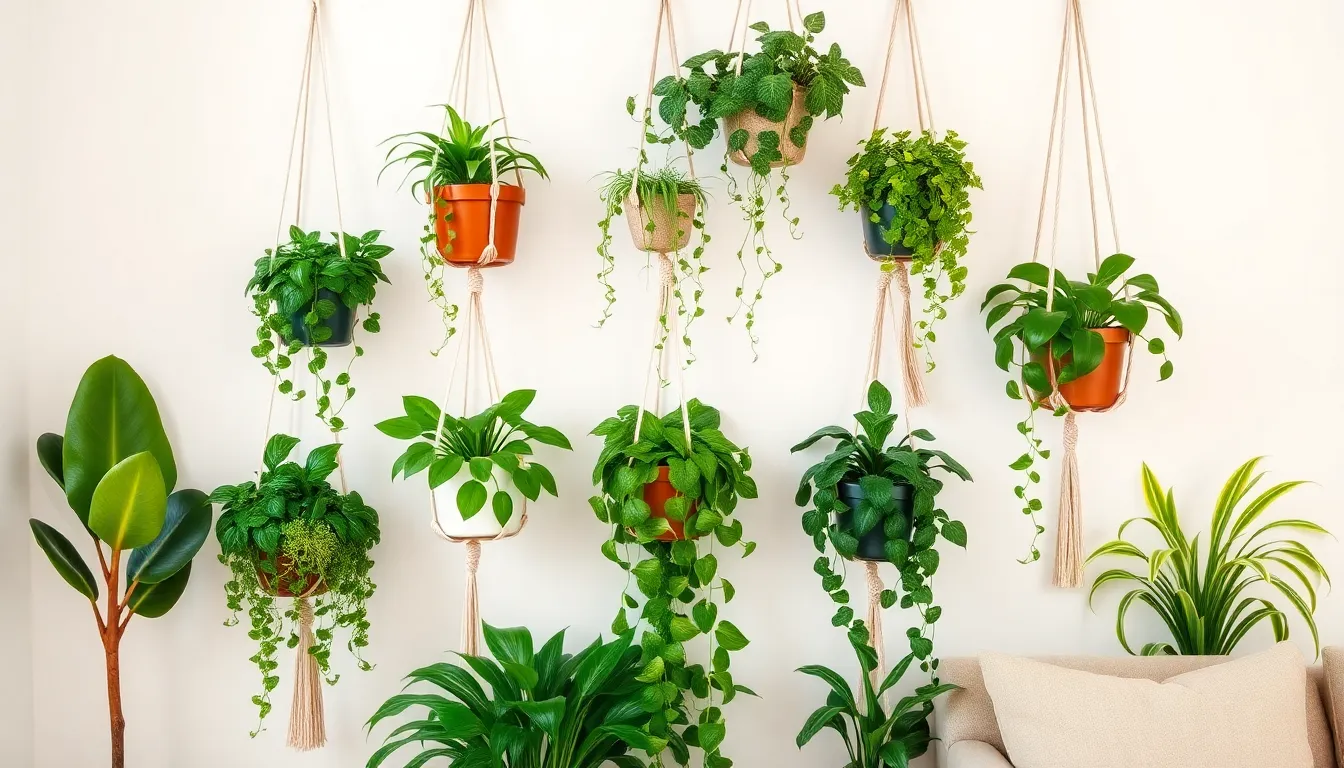
Now that we’ve covered the essentials of selecting low-maintenance plants, let’s explore how to transform your indoor space by growing upwards instead of outwards. Vertical gardening maximizes small indoor spaces while adding visual interest through varied heights, container types, and plant colors.
Wall-Mounted Planters and Hanging Gardens
Wall-mounted planters offer an excellent solution for creating living green walls in your home. We can fix these planters directly on walls or windows to enhance both air quality and aesthetics without sacrificing valuable floor space. Hanging gardens use ceiling hooks to suspend pots, which creates beautiful cascading displays perfect for trailing plants like ivy, pothos, or ferns.
These setups work particularly well for herbs, strawberries, nasturtiums, and peas that grow easily on vertical structures without requiring heavy-duty supports. DIY options include using recycled materials like plastic bottles or wooden pallets mounted on walls, making vertical gardening accessible on any budget. Specialized vertical planter pockets provide another cost-effective approach that maximizes light exposure while keeping plants organized.
Ladder Plant Stands and Tiered Shelving
Ladder plant stands create attractive multi-level displays that bring greenery to indoor rooms without crowding surfaces. We can place these versatile structures in corners or near windows to provide layers of growing space while maintaining easy access to each plant. Tiered shelving units allow us to group plants by their exact light needs or types, ensuring optimal growing conditions for each variety.
These vertical answers work exceptionally well for apartments or rooms with limited floor area, transforming cramped spaces into lush indoor gardens. Corner placement maximizes unused space while creating focal points that draw the eye upward, making rooms appear larger and more ever-changing.
Macrame Hangers and Ceiling Hooks
Macrame plant hangers suspended from ceiling hooks combine artistry with functionality, making plants a striking focal point in any room. We find these create-based holders particularly useful for small pots containing trailing plants, as they use ceiling space effectively while keeping surfaces clear and reducing clutter.
This decorative approach works best with lightweight containers and plants that cascade beautifully, such as string of pearls, spider plants, or small pothos varieties. Ceiling hooks support multiple hangers at varying heights, creating ever-changing displays that can even hide unsightly walls or provide natural privacy screens indoors.
Design Herb Gardens in Your Kitchen
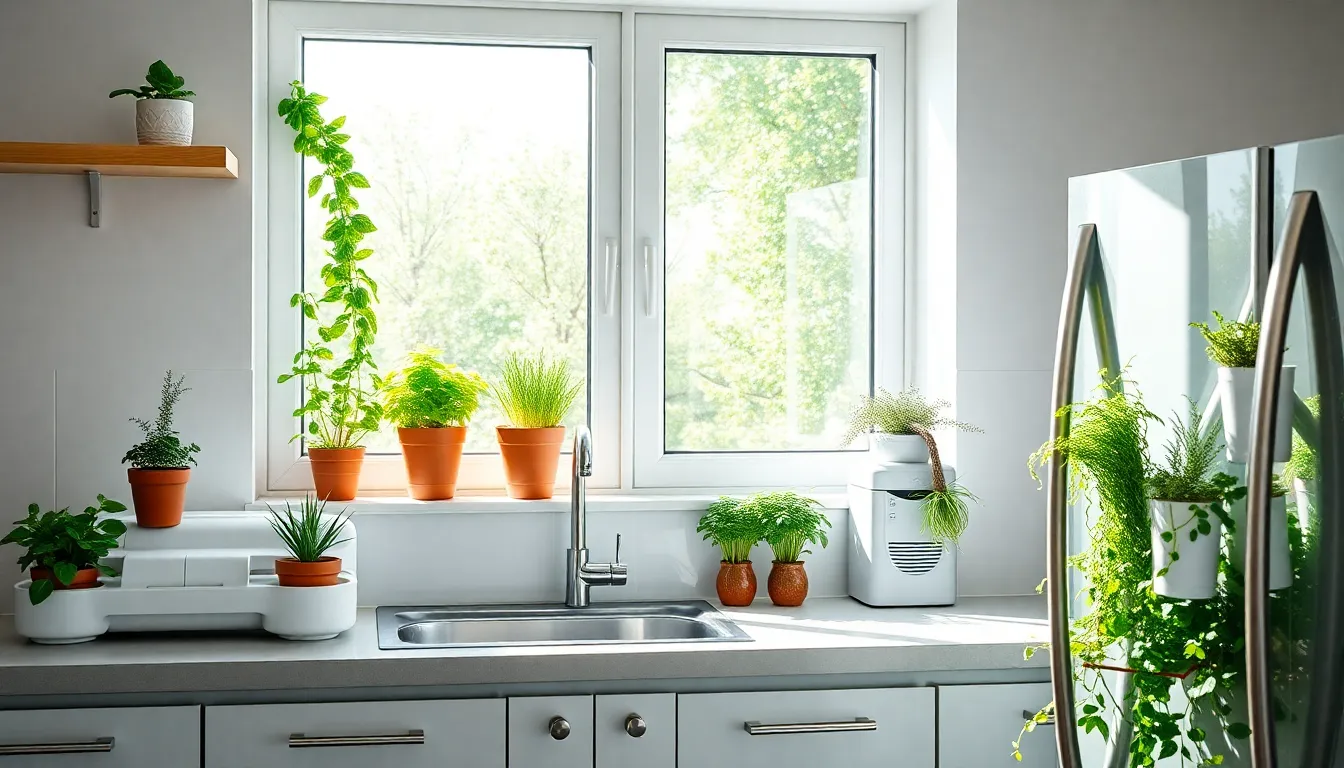
Building on vertical gardening concepts, we’ll transform your kitchen into a fresh herb haven using space-efficient growing methods. Kitchen herb gardens provide immediate access to chemical-free herbs while improving your culinary experience and reducing grocery costs.
Windowsill Herb Collections
Windowsills offer the perfect natural lighting conditions for growing small herb collections indoors. Sunny windowsills provide ideal growing conditions for herbs like basil, mint, and thyme in traditional soil-based pots. We can maximize this natural light source by arranging herbs in graduated heights along the windowsill.
Natural lighting from windows eliminates the need for artificial grow lights while creating beautiful green displays. Fresh herbs grown on windowsills add both aroma and visual appeal to kitchen spaces. Regular watering and occasional rotation ensure even growth and healthy herb development.
Space efficiency makes windowsill collections perfect for apartments and smaller kitchens. Small herb pots fit perfectly on standard windowsills without crowding the space. We can combine soil-based growing with small-scale hydroponic setups for variety and experimentation.
Countertop Hydroponic Systems
Countertop systems revolutionize indoor herb growing by using hydroponic technology in compact, toaster-sized units. These self-contained systems from brands like AeroGarden, Click & Grow, and SereneLife grow herbs, vegetables, and flowers without soil. Artificial lighting, nutrient-rich water, and controlled oxygen levels create optimal growing conditions.
Water efficiency makes hydroponic systems incredibly sustainable, using 80-90% less water than traditional soil gardening. Faster growth rates and year-round harvests provide continuous herb supplies regardless of outdoor weather conditions. Low maintenance requirements and reduced pest problems make these systems ideal for busy home cooks.
Space optimization allows countertop units to fit seamlessly into kitchen designs while providing maximum growing capacity. Multiple herbs can grow simultaneously in organized pod systems. We can harvest fresh herbs daily while new growth continues developing in the same unit.
Magnetic Planters for Refrigerator Doors
Magnetic planters use vertical space on refrigerator doors and other metal surfaces without occupying valuable counter space. These innovative planters attach securely to metal appliances, creating instant herb gardens in previously unused areas. Small herbs and plants thrive in these compact, soil-based growing containers.
Convenience factor makes magnetic planters extremely practical for small kitchens where counter space is premium. Easy access to fresh herbs during cooking enhances meal preparation efficiency. We can arrange multiple magnetic planters at different heights for visual interest and practical herb organization.
Decorative functionality transforms ordinary refrigerator doors into living herb displays that complement kitchen décor. Magnetic planters add functional beauty while keeping herbs within arm’s reach of cooking areas. These space-saving answers work perfectly in tiny kitchens, RVs, and studio apartments where every inch counts.
Transform Unused Corners Into Plant Sanctuaries

We’ll help you convert those forgotten corner spaces into lush indoor gardens that breathe life into your home. Corners offer unique opportunities for creating dramatic plant displays that maximize vertical space while adding natural beauty to overlooked areas.
Floor Plant Arrangements
Floor plant groupings create stunning naturalistic displays that fill empty corner spaces with vibrant greenery. We recommend clustering larger tropical vines like Pothos (Epipremnum aureum) and Philodendron species together for maximum visual impact. These plants thrive with indirect light and minimal watering, making them perfect for beginners who want impressive results without complicated care routines.
Pothos plants trail beautifully when placed on the floor, creating cascading green curtains that soften harsh corner angles. Philodendrons offer varied foliage forms that add textural interest to your arrangement while tolerating low to medium light conditions. Mix different pot sizes and heights to create depth and visual movement in your corner sanctuary.
Corner Plant Stands and Towers
Vertical plant stands maximize growing space while keeping floor areas clutter-free and organized. We suggest using corner towers that accommodate multiple plant levels, allowing you to display hanging, potted, and trailing specimens in one cohesive arrangement. These structures create layered green effects that draw the eye upward and make rooms feel larger.
Vining plants like pothos and philodendrons cascade beautifully down stand sides, improving the vertical garden aesthetic you’re creating. Incorporate different sized pots and various plant species to add visual interest while making the most of your corner’s vertical potential. This approach transforms single corners into impressive plant collections that serve as living art installations.
Reading Nook Greenery
Reading spaces become more inviting and relaxing when enhanced with carefully selected plants that improve both ambiance and air quality. We recommend medium-sized plants that thrive in indirect light, such as snake plants, ferns, or small palms for these cozy corners. Position plants on side tables, shelves, or in hanging planters near your reading area to create a natural, calming environment.
Choose plants that complement your reading habits rather than compete for attention with rustling leaves or strong fragrances. Their greenery adds soothing natural elements that reduce stress while you enjoy your favorite books. Consider the lighting conditions where you read most often, selecting species that will flourish in those exact conditions for long-term success.
Incorporate Air-Purifying Plants in Every Room
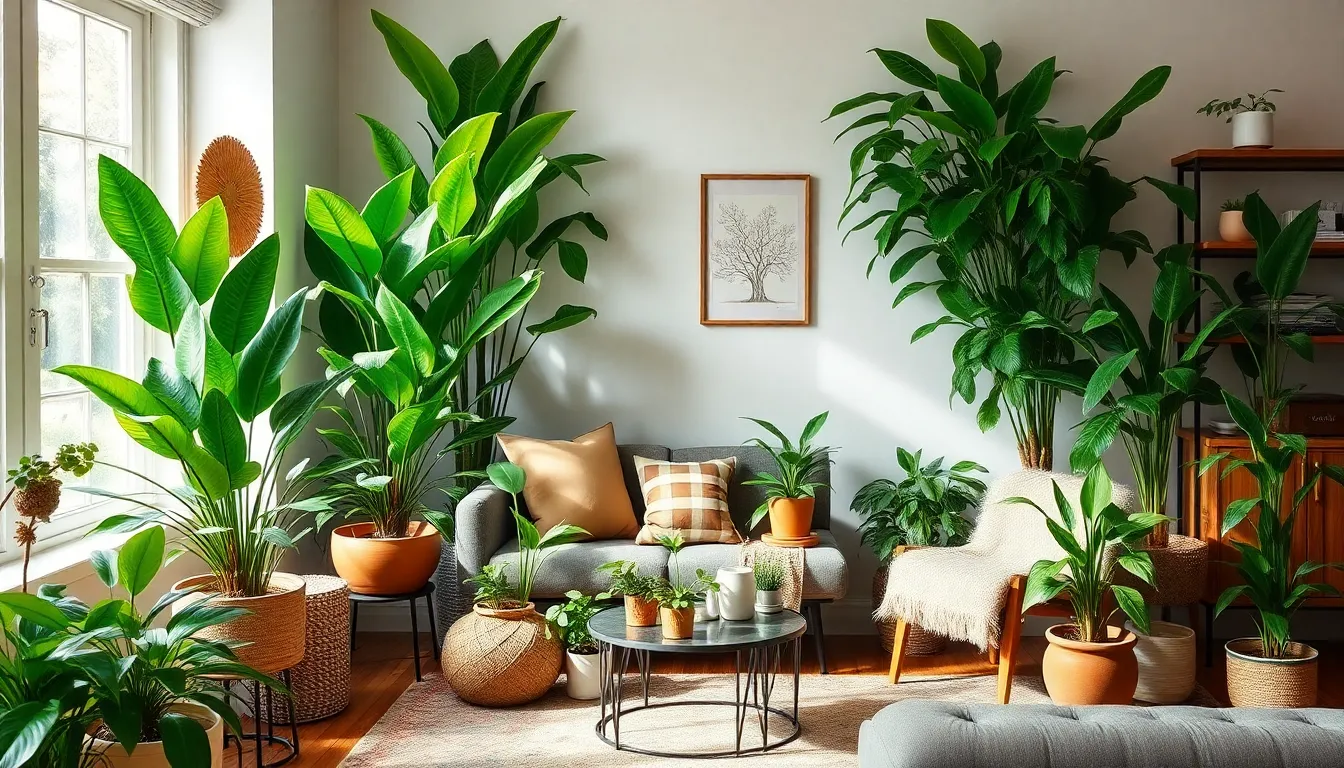
Now that we’ve explored maximizing space and creating functional growing areas, let’s focus on selecting plants that actively improve our indoor air quality while complementing each room’s unique environment.
Bedroom Plants for Better Sleep
Snake plants excel as bedroom companions because they release oxygen at night while requiring minimal maintenance. These resilient plants thrive in low light conditions and can tolerate weeks of neglect, making them perfect for busy households.
Peace lilies contribute to better sleep by improving humidity levels and filtering airborne particles that can disrupt breathing. They prefer moist soil and indirect light, conditions that bedrooms naturally provide.
Aloe vera plants offer dual benefits as bedroom additions, purifying air while providing a natural remedy for minor skin irritations. Their thick, succulent leaves store water efficiently, requiring watering only when soil feels completely dry.
These oxygen producing plants create a calming atmosphere that naturally promotes more restful sleep patterns.
Living Room Statement Plants
Rubber plants make bold focal points with their glossy, dark green leaves that reflect light beautifully throughout living spaces. They’re surprisingly easy to care for and can grow quite tall, creating dramatic vertical interest.
Philodendrons work as versatile living room additions, functioning as trailing plants in hanging baskets or climbing specimens on moss poles. Their heart shaped leaves add texture and movement to any room design.
Pothos varieties bring vibrant color to living areas with their variegated foliage patterns in green, yellow, and white combinations. They tolerate low to bright indirect light and grow quickly to fill empty spaces.
These statement plants serve as natural room dividers while continuously filtering air and adding life to our most used spaces.
Bathroom Humidity Loving Species
Boston ferns thrive in bathroom environments because they naturally prefer high humidity and indirect light conditions. Their delicate fronds create a spa like atmosphere while helping regulate moisture levels.
Peace lilies adapt perfectly to bathroom conditions, preferring the consistent moisture and warm temperatures that bathrooms provide. They’ll reward proper care with elegant white blooms several times per year.
Spider plants flourish in humid bathroom environments and produce baby plantlets that can be propagated to expand our collection. Their arching leaves create graceful cascading effects from shelves or hanging baskets.
These moisture loving plants transform bathrooms into refreshing retreats while improving air quality and managing humidity naturally.
Build DIY Terrarium Gardens for Small Spaces

Creating miniature ecosystems in glass containers lets us bring nature indoors while maximizing limited space. These self-contained gardens offer a unique way to display plants while requiring minimal maintenance.
Closed Terrarium Ecosystems
Sealed glass containers create perfect micro-environments that sustain themselves through natural water cycles. We start by layering 2-3cm of pebbles at the bottom for proper drainage, then add activated charcoal to filter the air inside. Potting soil goes on top, providing enough depth for plant roots to establish.
Positioning plants strategically enhances visual appeal while ensuring healthy growth. We place taller specimens near the back or off-center, leaving adequate space for each plant to develop. Mosses, ferns, and tropical species thrive in these humid conditions, creating lush miniature landscapes.
Watering frequency drops dramatically with closed systems requiring attention only every 4-6 months. The natural condensation cycle recycles moisture continuously inside the container. We monitor condensation levels on glass walls, removing the lid for 15 minutes to an hour if excessive moisture appears.
Open Terrarium Displays
Open containers like bowls and jars without lids accommodate plants that prefer airflow and lower humidity. Succulents and cacti flourish in these environments, enjoying the circulation that prevents moisture buildup. We water these systems weekly or when soil feels dry to the touch.
Application methods matter significantly for open terrarium success. Using spray bottles or small spoons prevents overwatering, which can quickly damage drought-loving plants. Creative decoration opportunities abound with rocks, bark chips, seashells, and miniature figurines personalizing each display.
Desktop Mini Gardens
Small terrariums transform workspaces and shelves into vibrant focal points that boost mood and air quality. These compact gardens fit perfectly on desks, bringing nature to areas where traditional plants might not work. Bright, indirect lighting works best, though fluorescent or LED grow lights can supplement natural light for 16-18 hours daily.
Maintenance routines stay simple with light watering, mold monitoring, and occasional lid adjustments. We check for dryness or excess moisture regularly, balancing humidity levels to keep plants healthy. These mini ecosystems serve as living décor that requires far less attention than traditional houseplants while delivering maximum visual impact.
Install Indoor Plant Lighting Systems
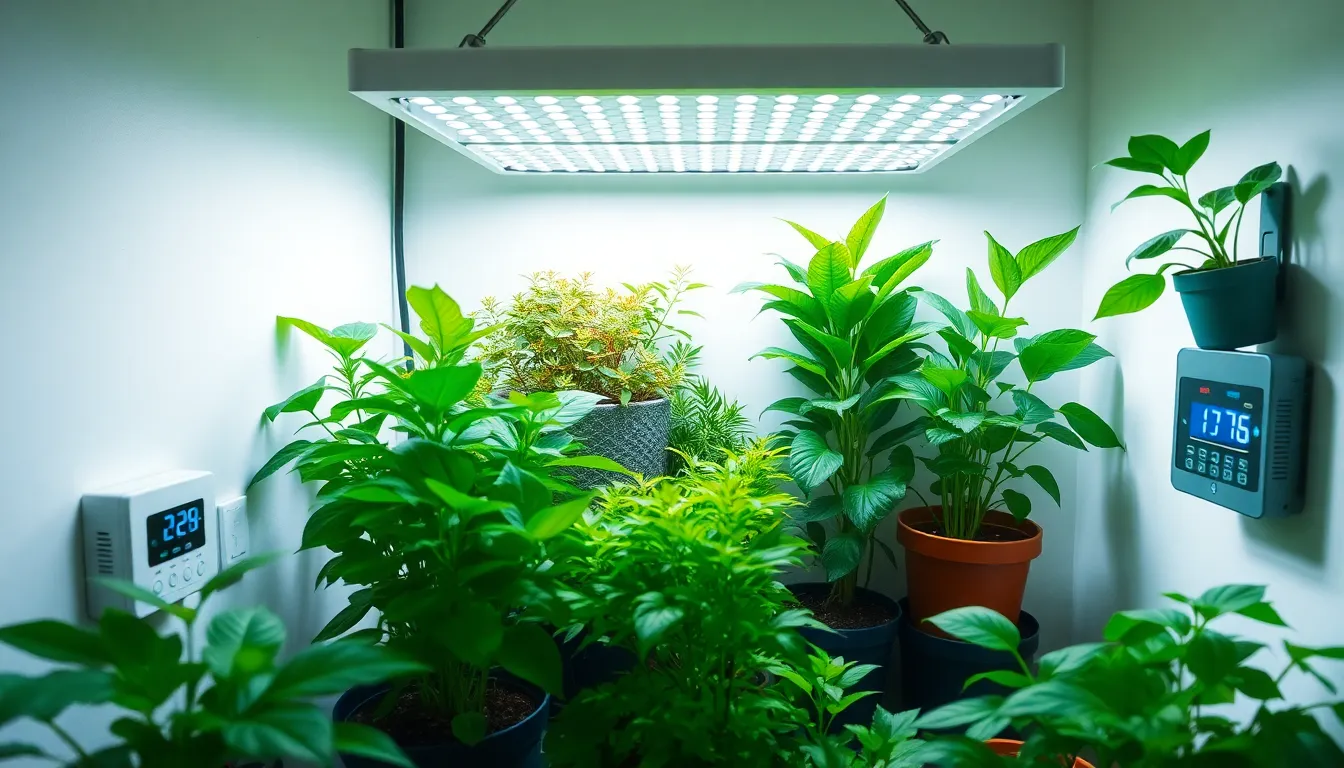
We’ll transform your home’s darker corners into thriving plant sanctuaries with proper lighting systems. Setting up effective indoor plant lighting ensures our green friends receive the energy they need for photosynthesis and healthy growth.
LED Grow Lights for Dark Spaces
LED grow lights offer the most energy-efficient solution for growing plants in areas with minimal natural sunlight. These versatile lighting systems emit exact red and blue wavelengths that plants need for healthy leaf development and flowering.
GE LED Grow Light Bulbs fit into standard lamp fixtures and provide an advanced red spectrum perfect for fruiting plants like tomatoes and peppers. We recommend running these bulbs for 18 hours daily to maximize their effectiveness for flowering plants.
Specialty LED systems like Soltech’s Vita Grow Bulb and Highland LED Track Light create customizable configurations for different garden sizes. Track lighting systems work exceptionally well for larger plant collections, while individual bulbs suit smaller setups.
Installation options include hanging fixtures for overhead coverage, adjustable stands for flexibility, and tabletop lights for desk gardens. Position lights 12-24 inches above plants to prevent burning while ensuring adequate coverage across all foliage.
Natural Light Optimization Techniques
Maximizing existing natural light reduces our reliance on artificial lighting while supporting plant health. Strategic placement near windows with indirect sunlight prevents harsh rays from scorching delicate leaves.
Reflective surfaces like mirrors or light-colored walls bounce ambient light throughout the room, effectively doubling the available illumination for nearby plants. White walls increase light reflection by up to 80% compared to darker surfaces.
Plant rotation ensures even light exposure by turning containers weekly so all sides receive equal illumination. This technique prevents plants from leaning toward light sources and promotes symmetrical growth.
Seasonal supplementation becomes necessary during shorter winter days when natural light decreases. Combining natural light with LED grow lights maintains consistent photoperiods year-round for optimal plant health.
Timer Systems for Consistent Care
Automated timer systems eliminate guesswork by maintaining precise lighting schedules without daily intervention. Most grow lights don’t include built-in timers, making external timer plugs essential for consistent plant care.
Daily light cycles should range from 12-18 hours depending on plant species and growth phase. Leafy greens typically need 14-16 hours, while flowering plants often require 12-14 hours for proper bloom development.
Timer plug advantages include preventing light burn from overexposure and ensuring plants receive adequate rest periods for cellular repair. Digital timers offer multiple programming options for different plant zones throughout your home.
Consistency benefits extend beyond convenience to improved plant health, as irregular lighting schedules can stress plants and reduce growth rates. Automated systems maintain optimal conditions even during travel or busy periods.
Create Themed Plant Collections
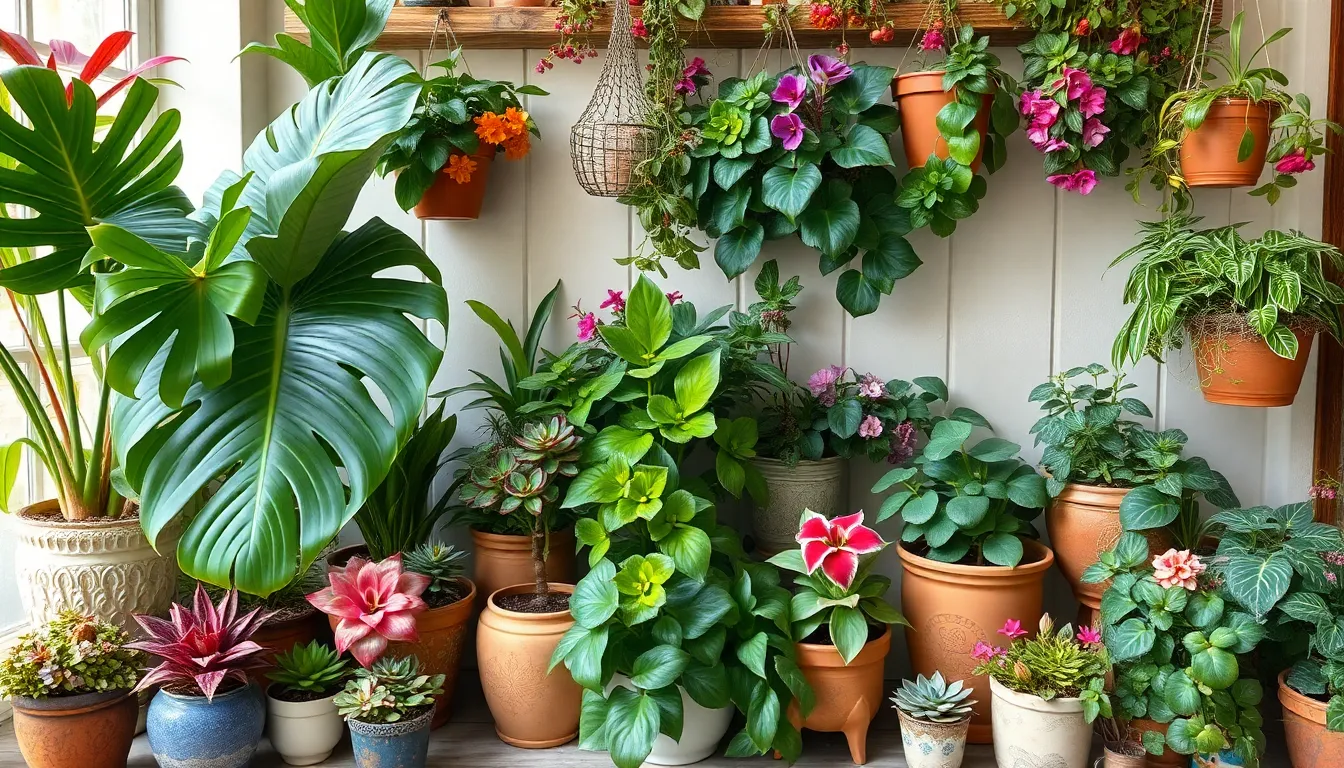
We can elevate our indoor gardening game by organizing plants into cohesive themed collections that reflect exact design aesthetics and growing conditions.
Tropical Paradise Indoor Jungle
Transform our living spaces into lush rainforest sanctuaries with large leafed tropical plants that create dramatic visual impact. Monstera deliciosa and Fiddle Leaf Fig serve as stunning centerpieces while Snake Plant, Peace Lily, and Calathea species add texture and color variation. Bright indirect light provides the perfect growing conditions for these humidity loving plants.
Arrange plants at multiple heights using floor planters, shelves, and hanging containers to mimic the layered canopy structure of natural jungles. Grouping several tropical plants together creates beneficial microclimates that boost growth rates and overall plant health. Regular misting sessions maintain the higher humidity levels these plants crave for optimal development.
Desert Succulent Gardens
Sunny windowsills become perfect showcases for low maintenance succulent collections that thrive with minimal care requirements. Echeveria, Aloe Vera, Haworthia, and Jade Plant varieties offer diverse shapes and colors while requiring sandy well draining soil. Shallow wide containers work best for these plants’ shallow root systems.
Decorative gravel and pebbles enhance the authentic desert aesthetic while providing practical drainage benefits. Bright direct sunlight suits these plants perfectly, making south facing windows ideal locations. Infrequent watering schedules make succulent gardens perfect for busy homeowners or beginners starting their indoor gardening journey.
Vintage Cottage Plant Arrangements
Soft foliage plants paired with delicate flowering varieties create charming nostalgic displays reminiscent of countryside cottages. Ferns, English Ivy, African Violets, and Spider Plants provide gentle textures that complement vintage decorating styles. Antique pots, distressed containers, woven baskets, and vintage tins serve as characterful planters.
Windowsill displays, tabletop arrangements, and macramé hanging planters distribute plants throughout our spaces while maintaining the cottage theme. Vintage household items like teacups, old books, and lace doilies function as decorative accents that enhance the nostalgic atmosphere. Pastel color schemes and floral pattern elements complete the vintage cottage aesthetic.
Design Self-Watering Plant Systems

Creating automated watering answers ensures our indoor plants receive consistent moisture without daily intervention. These systems help prevent both overwatering and underwatering while giving us freedom from strict watering schedules.
DIY Self-Watering Containers
Building our own self-watering containers takes about an hour and uses everyday materials we likely have at home. We can create a simple wicking system by placing a water reservoir at the base of our container and threading a fabric wick up into the soil above. The wick draws water from the reservoir as the soil dries, providing steady moisture to the plant roots.
Double pot setups work exceptionally well for larger plants like our tropical collections. We place one pot inside another, with the bottom pot holding water and the top containing our plant and soil. A cotton rope or fabric strip connects the two sections, allowing water to travel upward through capillary action. This method keeps soil consistently moist while preventing root rot from sitting water.
Mason jars and plastic bottles make excellent reservoir containers for smaller herb gardens and desk plants. We drill small holes in bottle caps and thread wicks through them, creating an effective delivery system that costs almost nothing to build.
Drip Irrigation for Multiple Plants
Installing a drip irrigation network lets us water multiple plants simultaneously with precise control over each one’s needs. We run a 16mm main pipe around our growing area’s perimeter, then branch smaller tubes to individual plant containers. Each plant gets its own adjustable dripper that we can customize based on size and water requirements.
Smart controllers transform basic drip systems into fully automated answers. We connect solenoid valves to programmable timers that deliver water on schedules we set for different plant zones. This automation ensures our philodendrons get daily moisture while our succulents receive water only twice weekly.
Balcony gardens benefit tremendously from drip irrigation since we can water plants in hard to reach corners without daily climbing and stretching. The system minimizes water waste compared to hand watering and delivers moisture directly to root zones where plants need it most.
Water Globe and Spike Answers
Water globes provide the simplest introduction to automated plant watering for our smaller houseplants. These glass or plastic reservoirs gradually release water through ceramic or plastic spikes inserted into the soil. As soil moisture decreases, air pressure changes allow more water to flow from the globe.
Spike systems work particularly well for our vacation care routine since they can sustain plants for several days or weeks depending on globe size. We fill the reservoir, insert the spike firmly into soil, and the device automatically adjusts water release based on soil conditions. Different spike materials control flow rates, with ceramic offering slower release than plastic versions.
Adjustable flow spikes let us fine tune watering rates for different plant types in our collection. We can restrict flow for drought tolerant species while allowing faster delivery for moisture loving ferns and peace lilies. These devices require no electricity or complex setup, making them perfect for our low maintenance plant care goals.
Establish Plant Care Routines and Organization
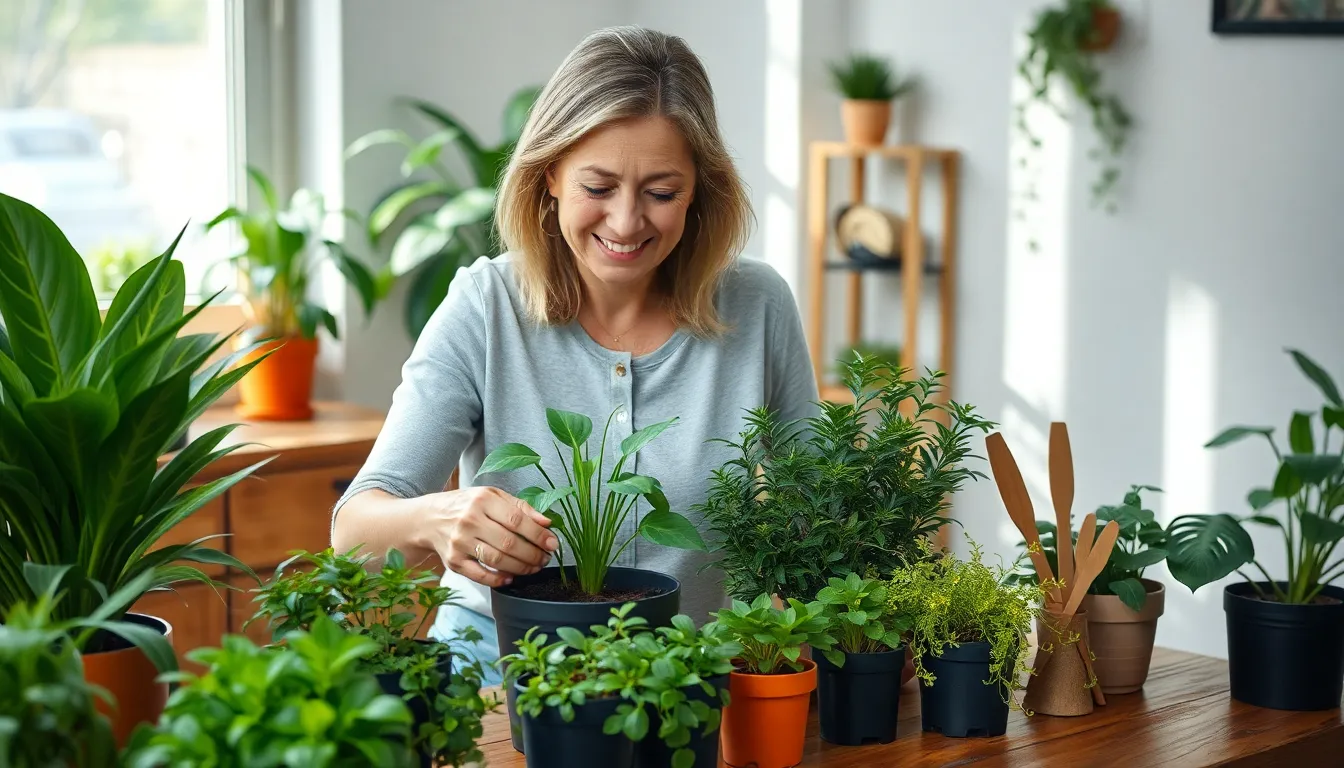
Now that we’ve explored lighting answers and plant collections, we need to focus on creating consistent care routines that’ll keep our indoor garden thriving year-round.
Weekly Watering Schedules
We should check our plants weekly by testing the top 1-2 inches of soil with our finger rather than following a rigid calendar schedule. Most indoor plants require watering every 1-2 weeks depending on their species and the current season. When we water, we need to saturate the soil thoroughly until excess water drains from the bottom holes, then allow the soil to dry before the next watering session.
Lifting each pot helps us gauge soil moisture by weight, which becomes an intuitive skill over time. We must avoid frequent light watering since it encourages shallow root growth and can lead to plant stress. Overwatering causes more plant deaths than underwatering, so we should err on the dry side especially for low-light species like ZZ plants.
Monthly Fertilizing and Pruning
We need to apply water-soluble fertilizer once or twice monthly during the active growing season from April through September. Outside these growing months, we should reduce or completely stop fertilizing since most plants enter dormancy during winter.
Monthly pruning involves removing dead or damaged foliage to encourage healthy new growth and prevent pest problems from taking hold. We should also inspect our plants for signs of pests during these monthly checks and dust the leaves to improve their photosynthesis efficiency. This regular maintenance keeps our plants looking their best while catching potential issues early.
Seasonal Plant Rotation Strategies
We should rotate our plants seasonally to manage their changing light and temperature needs throughout the year. Some plants need relocation to brighter spots during winter months, while others require protection from intense summer sun that can scorch their leaves.
Seasonal adjustments include reducing watering frequency and stopping fertilization during dormant winter periods when plant growth naturally slows down. We recommend repotting in late winter or early spring when plants prepare for active growth, using pots slightly larger than current ones with good drainage. Choosing sterile potting medium during repotting reduces transplant stress and gives our plants the best foundation for continued growth.
Conclusion
Creating your own indoor garden oasis is more achievable than you might think. We’ve shown you that with the right plant selections proper lighting and smart space-saving answers anyone can transform their home into a thriving green sanctuary.
The beauty of indoor gardening lies in its flexibility – whether you’re working with a sunny windowsill or a dark corner there’s always a way to bring nature indoors. From self-watering systems that simplify maintenance to themed collections that reflect your personal style the possibilities are endless.
We encourage you to start small and grow your confidence along with your plants. Remember that every expert gardener began as a beginner and your indoor garden will flourish with patience and consistent care. Your home deserves the fresh air improved ambiance and natural beauty that only plants can provide.
Frequently Asked Questions
What are the best low-maintenance indoor plants for beginners?
Snake plants, ZZ plants, pothos, and philodendrons are excellent choices for beginners. These plants are extremely forgiving, adapt to various lighting conditions, and require minimal watering. Spider plants and peace lilies are also great options as they tolerate occasional care mistakes while helping purify your indoor air naturally.
How can I maximize plant space in a small apartment?
Utilize vertical gardening techniques like wall-mounted planters, hanging gardens, and ladder plant stands. Create multi-level displays with tiered shelving, use macrame hangers for trailing plants, and try magnetic planters on your refrigerator. These solutions maximize growing space without taking up valuable floor area.
Which plants work best for kitchen herb gardens?
Basil, mint, thyme, and parsley thrive on sunny windowsills. Consider countertop hydroponic systems for soil-free growing, or use magnetic planters on your refrigerator door for easy access. These herbs grow quickly in kitchen conditions and provide fresh ingredients for cooking while enhancing your décor.
What are the best air-purifying plants for bedrooms?
Snake plants, peace lilies, and aloe vera are ideal for bedrooms. They release oxygen at night, require minimal maintenance, and effectively filter indoor air pollutants. These plants create a calming environment that can help improve sleep quality while adding natural beauty to your bedroom space.
How do I create a successful terrarium garden?
Use sealed glass containers for closed ecosystems that self-sustain through natural water cycles. Layer drainage materials, activated charcoal, and potting soil. Choose humidity-loving plants for closed terrariums or succulents for open displays. Desktop mini terrariums are perfect for small spaces and require minimal maintenance.
What lighting do indoor plants need in dark corners?
LED grow lights are energy-efficient solutions for darker areas. Use hanging fixtures or adjustable stands for optimal coverage. Maximize natural light with reflective surfaces and strategic plant placement. Automated timer systems help maintain consistent lighting schedules, ensuring healthy plant growth even in low-light conditions.
How can I create themed plant collections at home?
Try a “Tropical Paradise” theme with Monstera and Fiddle Leaf Fig plants in bright, indirect light. Create a “Desert Succulent Garden” with Echeveria and Aloe Vera on sunny windowsills. For “Vintage Cottage” style, use ferns and African Violets in charming vintage containers for soft, romantic appeal.
What are self-watering systems and how do they work?
Self-watering systems maintain consistent moisture without daily intervention. Create DIY versions using wicking systems or double pot setups. Water globes and spike systems work well for smaller plants, while drip irrigation networks handle multiple larger plants. These systems prevent both overwatering and underwatering issues.
How often should I water and fertilize my indoor plants?
Water based on soil moisture rather than a fixed schedule – most plants need watering when the top inch of soil feels dry. Fertilize monthly during growing seasons with diluted liquid fertilizer. Prune regularly to encourage healthy growth and inspect plants weekly for pest issues or signs of stress.
Which plants thrive in bathroom humidity?
Boston ferns, peace lilies, and spider plants love bathroom humidity and low-light conditions. These plants naturally thrive in moist environments and help improve air quality. Place them near windows for optimal light or use bathroom-safe grow lights to supplement natural illumination in windowless bathrooms.

